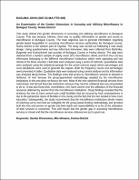| dc.description.abstract | BAGUMA JOHN (2007-03-MA-PTR-008)
An Examination of the Gender Dimensions in Accessing and Utilising Microfinance in
Buhaguzi County, Hoima District
This study delved into gender dimensions in accessing and utilising microfinance in Buhaguzi
County. This was because, hitherto, there was no quality information on gender and access to
microfinance in Buhaguzi County. The main objective was to generate information regarding
gender-based inequalities in accessing microfinance services particularly for Buhaguzi county,
hoima district in the western part of Uganda. The study was carried out following a case study
design. Using questionnaires and key informant interviews, data were collected from Buhimba,
Bugambe and Kiziranfumbi sub-counties of Buhaguzi County in Hoima district. The data were
obtained from a random sample of eighty seven (87) microfinance clients and from four (4) key
informants belonging to the different microfinance institutions which were operating and had
clients in the these counties. Field data were analysed using a series of methods. Quantitative data
were analysed using the statistical package for the social sciences (spss) where percentages and
cross tabulations were used to generate the outputs. Both the frequency counts and percentages
were presented in tables. Qualitative data were analysed using content analysis and its information
was analysed along themes. The findings show that access to microfinance services is skewed in
disfavour of men because the group-guaranteed methodology adopted by the microfinance
institutions in the area does not favour the men. Most of the men obtained financial services from
mainstream and formal financial institutions because they had the collateral that was necessitated
to do so. It was also found that, nevertheless, men have control over the utilisation of the financial
resources obtained by women from the microfinance institutions. Study findings revealed that the
tendency for men to have control over credit facilities that are secured by their wives/partners is
due to the patriarchal nature of families in the county and the fact that the men tended to have more
education. Subsequently, the study recommends that the microfinance institutions devise means
of reaching out to men that are ineligible for the group-based lending methodology and sensitise
both the men and women on gender and their rights and responsibilities in as far as the utilisation
of their services is concerned. This will ensure that the gender gap in accessing microfinance
services is closed and that the microfinance services obtained are put to good use.
Keywords: Gender Dimensions, Microfinance, Hoima District | en_US |


